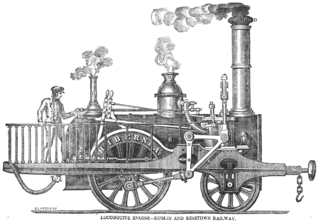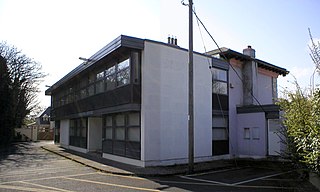
Gorey is a market town in north County Wexford, Ireland. It is bypassed by the main M11 Dublin to Wexford road. The town is also connected to the railway network along the same route. Local newspapers include the Gorey Guardian.

Limerick Junction is the interchange railway station for trains originating in Limerick, Dublin Heuston, Cork, Waterford, Tralee and Ennis stations. The station opened on 3 July 1848.

Pearse railway station or Dublin Pearse is a railway station on Westland Row on the Southside of Dublin, Ireland. It is Ireland's busiest commuter station and second busiest station overall with 9 million passenger journeys through the station in 2016.
A wide variety of steam locomotives have been used on Ireland's railways. This page lists most if not all those that have been used in the Republic of Ireland and Northern Ireland. Irish railways generally followed British practice in locomotive design.

The Dublin and South Eastern Railway (DSER), often referred to as the Slow and Easy, was an Irish gauge railway in Ireland from 1846 to 1925. It carried 4,626,226 passengers in 1911. It was the fourth largest railway operation in Ireland operating a main line from Dublin to Wexford, with branch lines to Shillelagh and Waterford. The company previously traded under the names Waterford, Wexford, Wicklow & Dublin Railway to 1848, Dublin and Wicklow Raillway (D&WR) to 1860 and Dublin, Wicklow and Wexford Railway (DW&WR) until 1906.

The Dublin and Kingstown Railway (D&KR), which opened in 1834, was Ireland's first passenger railway. It linked Westland Row in Dublin with Kingstown Harbour in County Dublin.

Wexford railway station is a railway station located in Wexford Town in County Wexford, Ireland.

Courtown is a village in County Wexford, Ireland. It was developed after Lord Courtown ordered the construction of a harbour during the Famine years, 1839–1846. The economic boost of the new harbour led to a small village developing with fishing being the primary economy of the village.

Dublin and Drogheda Railway (D&D) was a railway company in Ireland which publicly opened its 31¾ mile main line between Dublin and Drogheda in May 1844. It was the third railway company in Ireland to operate passenger trains and the first to use the Irish standard 5 ft 3 in gauge. It later opened branches to Howth and Oldcastle. The opening of the Dublin and Belfast Junction Railway (D&BJct) between the D&D at Drogheda and the Ulster Railway (UR) at Portadown in 1852 saw an almost continuous main line connection between Dublin and Belfast, which was resolved by the official opening of the Boyne Viaduct in April 1855. Amalgamations between these and other companies in 1875 and 1876 saw the creation of the Great Northern Railway of Ireland GNR(I).

Dublin and the Belfast Junction Railway (D&BJct) was an Irish gauge railway in Ireland. The company was incorporated in 1845 and opened its line in stages between 1849 and 1853, with the final bridge over the River Boyne opening in 1855. It linked the Ulster Railway (UR) from Belfast to Portadown and Dublin and Drogheda Railway (D&D) from Drogheda to Dublin, completing the missing link in the Belfast–Dublin line.

The Limerick–Tralee line, also known as the North Kerry line, is a former railway line from Limerick railway station to Tralee railway station in Ireland. It also has branch lines to Foynes and Fenit. Much of the line today has now been converted into a greenway, the Great Southern Trail.

Shankill railway station was a station on the Harcourt Street railway line. It served the suburb of Shankill, in County Dublin, Ireland.
Dublin, Wicklow and Wexford Railway (DW&WR) 52 to 54 were a class of three 4-4-2T locomotives designed by William Wakefield for Kingstown Pier to Kingsbridge boat trains. At one point they carried the names Duke of Connaught, Duke of Abercorn and Duke of Leinster respectively.
The Dublin, Wicklow and Wexford Railway (DW&WR) 2, built in 1885, was the predecessor to a total of eleven 2-4-0T locomotives to emerge from Grand Canal Street railway works between 1885 and 1896.
Dublin, Wicklow and Wexford Railway (DW&WR) 24 was the lead engine of a class of five 2-4-0 tender locomotives built in two batches in 1864 and 1873.
Dublin, Wicklow and Wexford Railway (DW&WR) 4 and 5 were a pair of 0-6-2T tank locomotives purchased from Kitson & Co. in 1897 and rebuilt as 0-6-0 tender Locomotives in 1908 due to a tendency to derail. Renumbered by Great Southern Railways to 448 and 449 they survived until 1940 and 1950 respectively.

Dublin, Wicklow and Wexford Railway (DW&WR) 55 to 58 were 4-4-0 locomotives built from 1895 at Vulcan Foundry for express passenger duties on the Dublin—Wexford mainline. They were to remain the DW&WR's and subsequent Dublin and South Eastern Railway's leading express passenger locomotive until the arrival of Nos. 67 and 68 some ten years later.

The Shillelagh branch line was a branch line of some 16.5 miles (26.6 km) to Shillelagh, County Wicklow opened by the Dublin, Wicklow and Wexford Railway (DW&WR) in 1865. It joined the Dublin–Rosslare railway line at Woodenbridge halt.
Dublin, Wicklow and Wexford Railway (DW&WR) 15 of 1860 was the first of a number of 0-4-2 tender locomotives built by Sharp Stewart who were the only supplier of the 0-4-2 type to the DW&WR. In total 12 were supplied in batches in 1860, 1864 and 1876.
The Dublin, Wicklow and Wexford Railway (DW&WR) Ariel Class refers to seven 2-2-2WT well tank locomotives built by Neilson and Company and introduced in 1865.













